
The megapodes, also known as incubator birds or mound-builders, are stocky, medium-large, chicken-like birds with small heads and large feet in the family Megapodiidae. Their name literally means "large foot" and is a reference to the heavy legs and feet typical of these terrestrial birds. All are browsers, and all but the malleefowl occupy wooded habitats. Most are brown or black in color. Megapodes are superprecocial, hatching from their eggs in the most mature condition of any bird. They hatch with open eyes, bodily coordination and strength, full wing feathers, and downy body feathers, and are able to run, pursue prey, and in some species, fly on the same day they hatch.

The Nicobar megapode or Nicobar scrubfowl is a megapode found in some of the Nicobar Islands (India). Like other megapode relatives, it builds a large mound nest with soil and vegetation, with the eggs hatched by the heat produced by decomposition. Newly hatched chicks climb out of the loose soil of the mound and being fully feathered are capable of flight. The Nicobar Islands are on the edge of the distribution of megapodes, well separated from the nearest ranges of other megapode species. Being restricted to small islands and threatened by hunting, the species is vulnerable to extinction. The 2004 tsunami is believed to have wiped out populations on some islands and reduced populations on several others.

The dusky megapode, also known as dusky scrubfowl or common megapode, is a medium-sized, approximately 41 cm long, blackish bird with a short pointed crest, bare red facial skin, dark legs, brown irises, and a dark brown and yellow bill. The male and female are similar. This terrestrial species lives in forests and swamps, including mangroves, of the Maluku and Raja Ampat Islands in Indonesia. Like other megapodes, it lays its eggs in a mound made from earth mixed with leaves, sand, gravel, and sticks, which can be as large as 11 m (36 ft) in diameter and stand nearly 5 m (16 ft) tall.
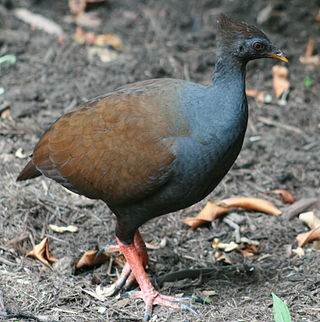
The orange-footed scrubfowl, also known as orange-footed megapode or just scrubfowl, is a small megapode of the family Megapodiidae native to many islands in the Lesser Sunda Islands as well as southern New Guinea and northern Australia.
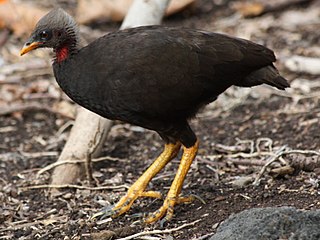
The Micronesian megapode or Micronesian scrubfowl is an endangered megapode which inhabits islands of the Western Pacific Ocean.

The Moluccan megapode, also known as Wallace's scrubfowl, Moluccan scrubfowl or painted megapode, is a small, approximately 31 cm long, olive-brown megapode. The genus Eulipoa is monotypic, but the Moluccan megapode is sometimes placed in Megapodius instead. Both sexes are similar with an olive-brown plumage, bluish-grey below, white undertail coverts, brown iris, bare pink facial skin, bluish-yellow bill and dark olive legs. There are light grey stripes on reddish-maroon feathers on its back. The young has brownish plumage, a black bill, legs and hazel iris.

The wattled brushturkey is a species of bird in the family Megapodiidae. It is found in New Guinea. Its natural habitats are subtropical or tropical moist lowland forest and subtropical or tropical moist montane forest.
The New Guinea scrubfowl or New Guinea megapode is a species of bird in the family Megapodiidae. It is found in New Guinea, mostly in the northern half. Its natural habitats are subtropical or tropical moist lowland forest and subtropical or tropical moist montane forest. This species was formerly known as Megapodius affinis but Roselaar, 1994, Bulletin of the Zoological Museum of the University of Amsterdam, 14, no.2, pp. 9–36 showed that Megapodius affinis A.B.Meyer, 1874 refers to M. reinwardt.

The Sula megapode or Sula scrubfowl is a species of bird in the family Megapodiidae. It is found only in the Banggai and Sula Islands between Sulawesi and the Maluku Islands in Indonesia, where its habitats are subtropical or tropical dry forest, subtropical or tropical moist lowland forest, subtropical or tropical mangrove forest, and subtropical or tropical moist shrubland. It is threatened by habitat destruction.

The Philippine megapode, also known as the Philippine scrubfowl or the Tabon scrubfowl, is a species of bird in the family Megapodiidae. It is found in the Philippines, northeastern Borneo, and Sulawesi. Its natural habitats are subtropical or tropical dry forest, subtropical or tropical moist lowland forest, and subtropical or tropical moist montane forest. The species was named after the collector Hugh Cuming.

The Melanesian scrubfowl or Melanesian megapode is a megapode species that is endemic to islands within Melanesia. The Melanesian scrubfowl has a unique strategy of egg incubation in which it relies on environmental heat sources. This bird species is culturally important for Indigenous peoples in Melanesia.

The Vanuatu megapode or Vanuatu scrubfowl is a species of bird in the family Megapodiidae. It was formerly known as the New Hebrides scrubfowl. It is found only in Vanuatu. Its natural habitat is subtropical or tropical moist lowland forest. The species is threatened by habitat loss and egg collecting.
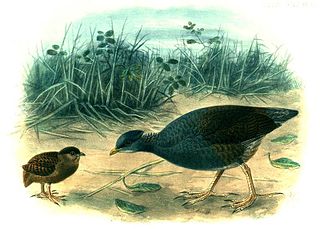
The Tongan megapode is a species of bird in the megapode family, Megapodiidae, currently endemic to Tonga. The species is also known as the Polynesian megapode, and as the Niuafo'ou megapode after the island of Niuafo'ou to which it was restricted for many years. The specific epithet honours British consul William Thomas Pritchard.
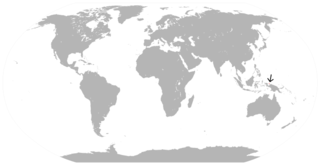
The Biak gerygone is a species of bird in the family Acanthizidae. It is endemic to the islands of Biak and Supiori in West Papua, Indonesia.
The Biak monarch, or Biak monarch flycatcher, is a species of bird in the family Monarchidae. It is endemic to Biak Island, Indonesia.

The island monarch is a species of bird in the family Monarchidae. It is found from Sulawesi to the Solomon Islands. Its natural habitats are subtropical or tropical moist lowland forests and subtropical or tropical moist montane forests.
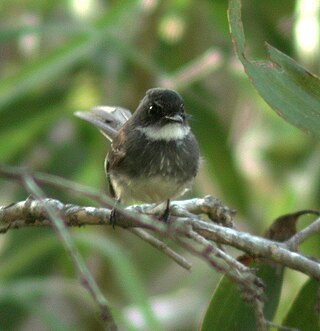
The northern fantail is a species of bird in the family Rhipiduridae. It is found in New Guinea and northern Australia . Its natural habitats are subtropical or tropical moist lowland forests and subtropical or tropical mangrove forests. The Biak fantail was formerly considered a subspecies.

The grey-capped pygmy woodpecker is an Asian bird species of the woodpecker family (Picidae). It has a subspecies, Yungipicus canicapillus doerriesi, located primarily in Manchuria, eastern Siberia, and Korea. Some taxonomic authorities continue to place this species in the genus Dendrocopos or Picoides.
The Tanimbar megapode or Tanimbar scrubfowl is a small megapode endemic to the Tanimbar Islands of Indonesia. It is sometimes considered to be a subspecies of the orange-footed scrubfowl, Megapodius reinwardt.
The Biak triller is a species of bird in the family Campephagidae. It is found on Biak. Its natural habitats are subtropical or tropical moist lowland forests and subtropical or tropical mangrove forests. It was formerly considered a subspecies of the black-browed triller, but was split as a distinct species by the IOC in 2021.

















